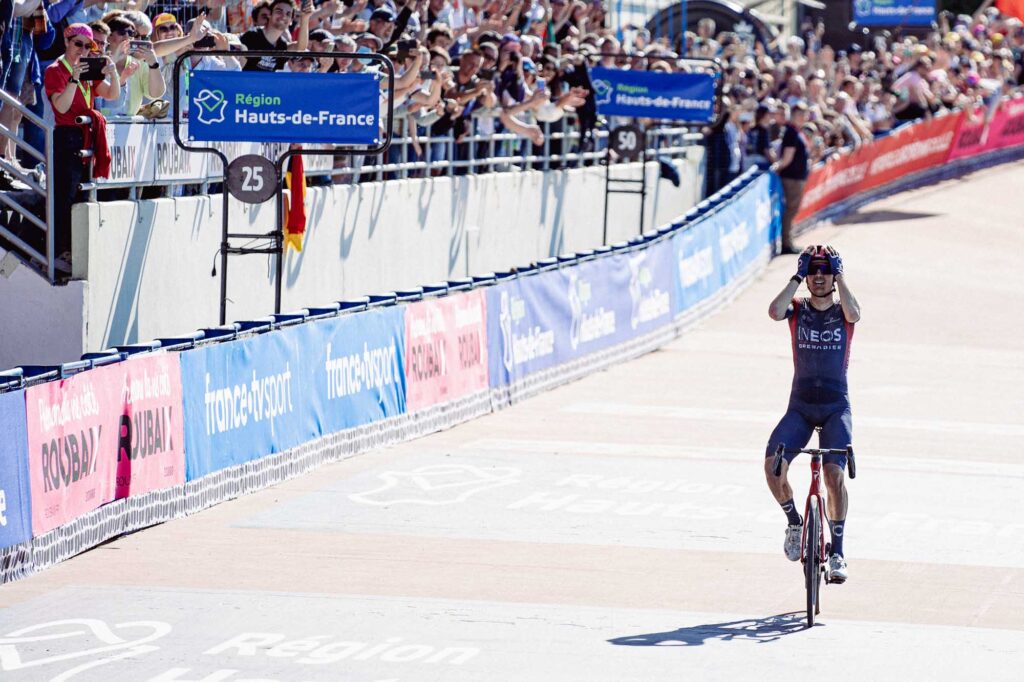Words by Jeremy Whittle | Photo by Zac Williams/SWpix.com
Ineos Grenadiers have established themselves as the cobbled kings of 2022 after taking a long-awaited success in this year’s Paris-Roubaix.
When Dylan Van Baarle wheeled to a halt and sank, sweaty, dusty and tearful, into the arms of Ineos Grenadiers’ team boss Dave Brailsford, just beyond the finish line in Roubaix’s old velodrome, the dream of British-sponsored success in the Queen of the Classics was finally fulfilled, a decade after it had first taken wing.
If there’s one race, other than the Tour de France, that British fans romanticise and revere, it’s Paris-Roubaix. Ideally, Sean Yates, who as a professional rode so well, so often in the Hell of the North, would have been sports director to that first British success. But Yates left Team Sky long ago and maybe it was just as fitting that Dutchman Servais Knaven, winner in Roubaix in 2001, was one of those to steer compatriot Van Baarle to success.
A decado ago, as Team Sky embarked on the European adventure that led to Tour de France success, there were high hopes that Bradley Wiggins, Geraint Thomas, or maybe Luke Rowe would claim the Queen of the Classics. But that never really looked likely, until this year, when as Ineos Grenadiers, a blend of youth and experience really started to coalesce.
As the season wore on and March turned to April, Van Baarle, Michal Kwiatkowski and Rowe dovetailed with more youthful talents such as Tom Pidcock, Magnus Sheffield and Ben Turner, to slip into the void left by a misfiring Quickstep Alpha Vinyl team. But this didn’t happen overnight and in February and March there were few hints of what was to come. In Milan-San Remo, for example, the team’s best-placed finisher was Kwiatkowski, who took 16th.
Van Baarle took eighth in the E3 Saxo Bank Classic at the end of March, but in Ghent-Wevelgem their best finish was Turner, in 28th. Pidcock and Turner hinted at good things to come when both finished in the top ten at Dwaars Door Vlaanderen, but it was Van Baarle himself who lit the fuse for the Grenadiers with his unexpected second place in the Tour of Flanders.
Calm is a good adjective for the stealthy Van Baarle, who appears to keep his head while all round are losing theirs, a characteristic that is pretty well-suited to the chaos of the Hell of the North.
It’s ironic to think back on how unnoticed that performance was, clouded as it was by Tadej Pogacar’s petulant post-sprint outburst aimed at Van Baarle and the ongoing debate on how the double Tour de France winner managed to come fourth in a two man sprint. But as the polemics raged, to his credit, Ineos’ Dutch rider stayed unflappable.
Calm is a good way to describe the stealthy Van Baarle, who appears to keep his head while all round are losing theirs, a characteristic that is pretty well-suited to the chaos of the Hell of the North. As the crashes and carnage, mishaps and mechanicals rained down on the peloton, leaving the hopes of many crushed into the dust, he threaded his way to the front and once he got there, stayed there.

Among those who did bite the dust was Yves Lampaert, who clipped an applauding spectator just seven kilometres from the velodrome, as he gave chase of Van Baarle, with Matej Mohoric. There was little real hope at that point of catching the Dutchman, but Lampaert’s sickening somersault summed up his Quickstep Alpha Vinyl team’s catastrophic Classics campaign.
“I want to cut that right turn and normally the supporters go backwards. But that man brings his arm forward and hits my arm,” Lampaert said. “If you don’t know anything about the race, stay home….there was still a podium place in it. Mohoric and Van Baarle were stronger than me, third place was perhaps just achievable.”
It was, although less disastrous, another ‘Opi-Omi’ moment, similar to the mass crash in last year’s Tour de France caused by a spectator stepping into the road with a banner bearing greetings to her family. That fan was hit by public outrage and a 1,200 euro fine.
If anything it highlighted, yet again, the risks associated with big crowds at the biggest races, many of whom aren’t die-hard cycling fans who don’t appreciate either the proximity or the speed of the riders. Whatever the fallout, don’t expect Quickstep’s increasingly ashen-faced supremo, Patrick Lefevere, to be in conciliatory mood.
Yet it was another epic edition — and the fastest-ever — of the Hell of the North. There were crashes, mechanicals, punctures and collapsed wheels. There was blood, sweat and tears. Once again, Paris-Roubaix had everything, just as it did last autumn when it made it’s post pandemic comeback. It remains the jewel in the crown of the Spring Classics, the most evocative and dramatic of the one-day races. That’s why winning it, after such a long wait, means so much to Brailsford and his team.






